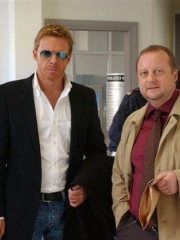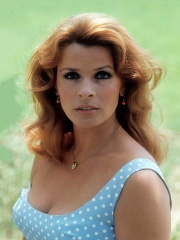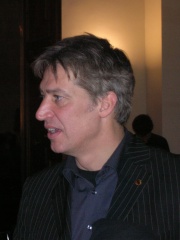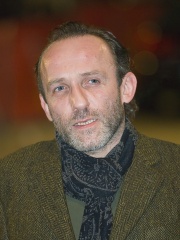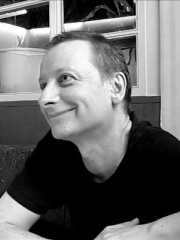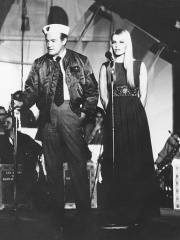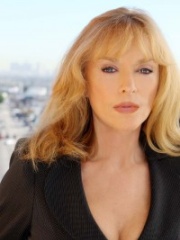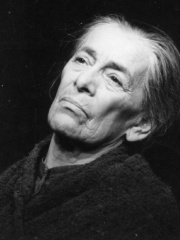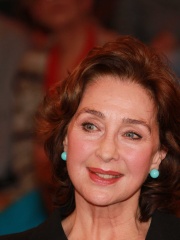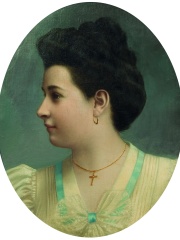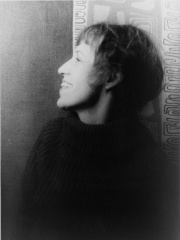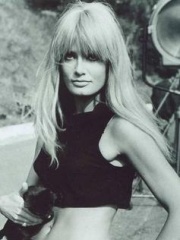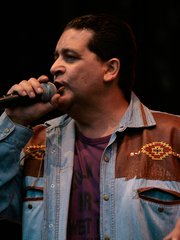
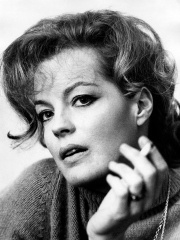
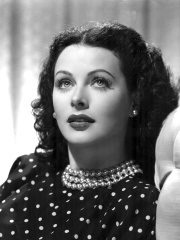
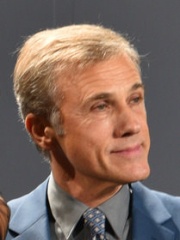
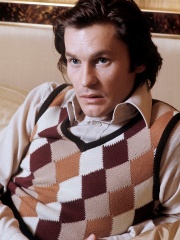
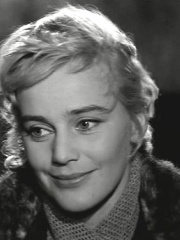

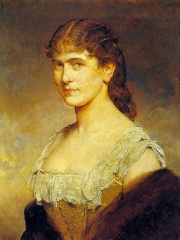
The Most Famous
ACTORS from Austria
Top 10
The following people are considered by Pantheon to be the top 10 most legendary Austrian Actors of all time. This list of famous Austrian Actors is sorted by HPI (Historical Popularity Index), a metric that aggregates information on a biography's online popularity. Visit the rankings page to view the entire list of Austrian Actors.

1. Arnold Schwarzenegger (b. 1947)
With an HPI of 83.44, Arnold Schwarzenegger is the most famous Austrian Actor. His biography has been translated into 122 different languages on wikipedia.
Arnold Alois Schwarzenegger (born July 30, 1947) is an Austrian and American actor, businessman, former politician, and former professional bodybuilder, known for his roles in high-profile action films. He served as the 38th governor of California from 2003 to 2011. Schwarzenegger began lifting weights at age 15 and won the Mr. Universe title aged 20, and subsequently the Mr. Olympia title seven times. He is tied with Phil Heath for the joint-second number of all-time Mr. Olympia wins, behind Ronnie Coleman and Lee Haney, who are joint-first with eight wins each. Nicknamed the "Austrian Oak" in his bodybuilding days, he is regarded as one of the greatest bodybuilders of all time. He has written books and articles about bodybuilding, including the autobiographical Arnold: The Education of a Bodybuilder (1977) and The New Encyclopedia of Modern Bodybuilding (1998). The Arnold Sports Festival, the second-most prestigious bodybuilding event after the Mr. Olympia competition, is named after him. He appeared in the bodybuilding documentary Pumping Iron (1977), which set him on his way to a career in films. After retiring from bodybuilding, Schwarzenegger gained worldwide fame as a Hollywood action star, with his breakthrough in the sword and sorcery epic Conan the Barbarian (1982), a box-office success with a sequel in 1984. After playing the title character in the science fiction film The Terminator (1984), he starred in Terminator 2: Judgment Day (1991) and three other sequels from 2003 to 2019. His other successful action films included Commando (1985), The Running Man (1987), Predator (1987), Total Recall (1990), and True Lies (1994), in addition to comedy films such as Twins (1988), Kindergarten Cop (1990) and Jingle All the Way (1996). At the height of his career, Schwarzenegger was known for his rivalry with Sylvester Stallone. Films in which he has appeared have grossed over $5.4 billion worldwide. He is the founder of the film production company Oak Productions. As a registered member of the Republican Party, Schwarzenegger chaired the President's Council on Physical Fitness and Sports during most of the George H. W. Bush administration. In 2003, he was elected governor of California in a special recall election to replace Gray Davis, the governor at the time. He received 48.6 percent of the vote, 17 points ahead of the runner-up, Cruz Bustamante of the Democratic Party. He was sworn in on November 17 to serve the remainder of Davis' term, and was reelected in the 2006 gubernatorial election with an increased vote share of 55.9 percent to serve a full term. In 2011, he reached his term limit as governor and returned to acting. As of 2025, Schwarzenegger and insurance commissioner Steve Poizner are the last Republicans to win or hold statewide office in California, having both won their respective elections in 2006.

2. Romy Schneider (1938 - 1982)
With an HPI of 80.88, Romy Schneider is the 2nd most famous Austrian Actor. Her biography has been translated into 59 different languages.
Rosemarie Magdalena Albach (23 September 1938 – 29 May 1982), known professionally as Romy Schneider (German: [ˈʁoːmi ˈʃnaɪdɐ, ˈʁɔmi -] ), was a German and French actress. She is regarded as one of the greatest screen actresses of all time and became a cult figure due to her role as Empress Elisabeth of Austria in the Sissi trilogy in the mid-1950s. She later reprised the role in a more mature version in Luchino Visconti's Ludwig (1973). She began her career in the German Heimatfilm genre in the early 1950s when she was 15. Schneider moved to France, where she made successful and critically acclaimed films with some of the most notable film directors of that era. Coco Chanel called Romy "the ultimate incarnation of the ideal woman". Bertrand Tavernier remarked: "Sautet is talking about Mozart with regard to Romy. Me, I want to talk of Verdi, Mahler..."

3. Hedy Lamarr (1914 - 2000)
With an HPI of 79.21, Hedy Lamarr is the 3rd most famous Austrian Actor. Her biography has been translated into 82 different languages.
Hedy Lamarr (; born Hedwig Eva Maria Kiesler; November 9, 1914 – January 19, 2000) was an Austrian and American actress and inventor. After a brief early film career in Czechoslovakia, including the controversial erotic romantic drama Ecstasy (1933), she fled from her first husband, Friedrich Mandl, and secretly moved to Paris. Traveling to London, she met Louis B. Mayer, who offered her a film contract in Hollywood. Lamarr became a film star with her performance in the romantic drama Algiers (1938). She achieved further success with the Western Boom Town (1940) and the drama White Cargo (1942). Lamarr's most successful film was the religious epic Samson and Delilah (1949). She also acted on television before the release of her final film in 1958. She was honored with a star on the Hollywood Walk of Fame in 1960. At the beginning of World War II, along with composer George Antheil, Lamarr co-invented a radio guidance system for Allied torpedoes that used spread spectrum and frequency hopping technology to defeat the threat of radio jamming by the Axis powers. This approach, conceptualized as a "Secret Communication System," was intended to provide secure, jam-resistant communication for weapon guidance by spreading the signal across multiple frequencies. Similar technology was used in operational systems only beginning in 1962, which was well after World War II and three years after the expiry of the Lamarr-Antheil patent. Frequency hopping, which existed and was utilized before the Lamarr-Antheil patent, is a foundational technology for spread spectrum communications. Its principles are utilized for secure wireless networking, including Bluetooth and early versions of Wi-Fi, which use variants of spread spectrum to protect data from interception and interference.

4. Christoph Waltz (b. 1956)
With an HPI of 75.13, Christoph Waltz is the 4th most famous Austrian Actor. His biography has been translated into 70 different languages.
Christoph Waltz (German: [ˈkʁɪstɔf ˈvalts]; born 4 October 1956) is an Austrian and German actor. Primarily active in the United States, he gained international recognition for his portrayal of villainous and supporting roles in English-language films. His accolades include two Academy Awards, two Golden Globe Awards, two BAFTA Awards, two Screen Actors Guild Awards, two Critics' Choice Movie Awards in addition to nomination for an Emmy Award. After a substantial career in German television and theatre, Waltz's American breakthrough role came in Quentin Tarantino's 2009 film Inglourious Basterds, in which he played Hans Landa, for which he received the Academy Award for Best Supporting Actor and the Cannes Film Festival Best Actor Award. He collaborated with Tarantino again in Django Unchained (2012), for which he earned his second Academy Award for Best Supporting Actor, this time for his performance as a bounty hunter named Dr. King Schultz. He has also starred in Carnage (2011), The Zero Theorem (2013), Big Eyes (2014), Downsizing (2017), Alita: Battle Angel (2019), The French Dispatch (2021), Frankenstein and Dracula: A Love Tale (both 2025). He appeared as Ernst Stavro Blofeld in the James Bond films Spectre (2015) and No Time to Die (2021).
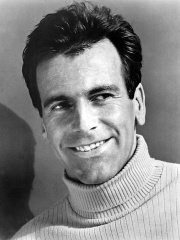
5. Maximilian Schell (1930 - 2014)
With an HPI of 73.78, Maximilian Schell is the 5th most famous Austrian Actor. His biography has been translated into 72 different languages.
Maximilian Schell (8 December 1930 – 1 February 2014) was a Swiss actor, theatre director, filmmaker, and musician of Austrian origin. He was one of the most internationally-acclaimed German-speaking actors of his generation, earning accolades for his work on both screen and stage. Born and initially raised in Vienna, his parents were involved in the arts and he grew up surrounded by performance and literature. While he was still a child, his family fled to Switzerland in 1938 when Austria was annexed by Nazi Germany, and they settled in Zürich. After the Second World War, Schell took up acting and directing full-time. Schell won the Academy Award for Best Actor for playing a lawyer in the legal drama Judgment at Nuremberg (1961). He was Oscar-nominated for playing a character with multiple identities in The Man in the Glass Booth (1975) and for playing a man resisting Nazism in Julia (1977). Fluent in both English and German, Schell earned top billing in a number of Nazi-era themed films. He acted in films such as Topkapi (1964), The Deadly Affair (1967), Counterpoint (1968), Simón Bolívar (1969), The Odessa File (1974), A Bridge Too Far (1977), and Deep Impact (1998). He made his film directorial debut with the period romantic drama First Love (1970), and would be nominated for the German Film Award for Best Director three times. On television, he received two Primetime Emmy Award nominations for the NBC film Miss Rose White and the HBO television film Stalin (1992), the later of which earned him the Golden Globe Award for Best Supporting Actor – Series, Miniseries or Television Film. He also portrayed Otto Frank in the TV film The Diary of Anne Frank (1980), the Russian emperor Peter the Great in the NBC series Peter the Great (1986), Frederick the Great in the British series Young Catherine (1991), and Brother Jean le Maistre in the miniseries Joan of Arc (1999). Schell also performed in a number of stage plays, including a celebrated performance as Prince Hamlet, and was a director of stage plays and operas. He was an accomplished pianist and conductor, performing with Claudio Abbado and Leonard Bernstein, and with orchestras in Berlin and Vienna. The Deutsches Filminstitut called him "a universal artist." His elder sister was actress Maria Schell; he directed the documentary tribute My Sister Maria in 2002.

6. Helmut Berger (1944 - 2023)
With an HPI of 71.64, Helmut Berger is the 6th most famous Austrian Actor. His biography has been translated into 33 different languages.
Helmut Berger (German pronunciation: [ˈhɛlmuːt ˈbɛʁɡɐ] ; né Steinberger; 29 May 1944 – 18 May 2023) was an Austrian actor, known for his portrayal of narcissistic and sexually ambiguous characters. He was one of the stars of European cinema in the late 1960s and 1970s, and is regarded as a sex symbol and pop icon of that period. He is most famous for his work with Luchino Visconti, particularly in his performance as King Ludwig II of Bavaria in Ludwig, for which he received a special David di Donatello award, and his performance in The Damned for which he was nominated for a Golden Globe Award.

7. Maria Schell (1926 - 2005)
With an HPI of 69.42, Maria Schell is the 7th most famous Austrian Actor. Her biography has been translated into 36 different languages.
Maria Margarethe Anna Schell (15 January 1926 – 26 April 2005) was an Austrian-Swiss actress. She was one of the leading stars of German cinema in the 1950s and 1960s. In 1954, she was awarded the Cannes Best Actress Award for her performance in Helmut Käutner's war drama The Last Bridge, and in 1956, she won the Volpi Cup for Best Actress at the Venice Film Festival for Gervaise.

8. Klaus Maria Brandauer (b. 1943)
With an HPI of 68.69, Klaus Maria Brandauer is the 8th most famous Austrian Actor. His biography has been translated into 36 different languages.
Klaus Maria Brandauer (Austrian German: [klaʊs maˈriːa ˈbrandaʊɐ] ; born Klaus Georg Steng; 22 June 1943) is an Austrian actor and director. He is also a professor at the Max Reinhardt Seminar. Brandauer is known internationally for his roles in Mephisto (1981), Never Say Never Again (1983), Hanussen (1988), Burning Secret (1988), The Russia House (1990), and White Fang (1991). For his supporting role as Bror von Blixen-Finecke in Out of Africa (1985), he was nominated for an Academy Award and won a Golden Globe Award. Brandauer has a working knowledge of and has acted in at least five languages including German, Italian, Hungarian, English and French.

9. Katharina Schratt (1853 - 1940)
With an HPI of 68.34, Katharina Schratt is the 9th most famous Austrian Actor. Her biography has been translated into 19 different languages.
Katharina Schratt, Baroness Kiss von Ittebe (11 September 1853 – 17 April 1940) was an Austrian actress who became "the uncrowned Empress of Austria" as a confidante of Emperor Franz Joseph.
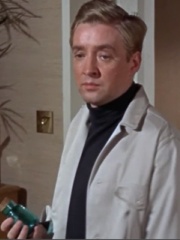
10. Oskar Werner (1922 - 1984)
With an HPI of 66.74, Oskar Werner is the 10th most famous Austrian Actor. His biography has been translated into 37 different languages.
Oskar Werner (German: [ˈɔskaʁ ˈvɛʁnɐ]; born Oskar Josef Bschließmayer; 13 November 1922 – 23 October 1984) was an Austrian stage and cinema actor who reached international fame. His most prominent roles include two 1965 films, The Spy Who Came In from the Cold and Ship of Fools. For the former, Werner won a Golden Globe Award. For the latter, Werner received an Oscar nomination. Other notable films include Decision Before Dawn (1951), Lola Montès (1955), Jules and Jim (1962), Fahrenheit 451 (1966), The Shoes of the Fisherman (1968), and Voyage of the Damned (1976). Werner accepted both stage and film roles throughout his career. He won a New York Film Critics Circle Award, a Golden Globe Award for Best Supporting Actor and was nominated two additional Golden Globes, as well as two BAFTA Awards, and an Academy Award, among other honors.
People
Pantheon has 69 people classified as Austrian actors born between 1790 and 1995. Of these 69, 21 (30.43%) of them are still alive today. The most famous living Austrian actors include Arnold Schwarzenegger, Christoph Waltz, and Klaus Maria Brandauer. The most famous deceased Austrian actors include Romy Schneider, Hedy Lamarr, and Maximilian Schell. As of April 2024, 4 new Austrian actors have been added to Pantheon including Michel Muller, Roland Kickinger, and Tony Wegas.
Living Austrian Actors
Go to all RankingsArnold Schwarzenegger
1947 - Present
HPI: 83.44
Christoph Waltz
1956 - Present
HPI: 75.13
Klaus Maria Brandauer
1943 - Present
HPI: 68.69
Martin Weinek
1964 - Present
HPI: 66.00
Senta Berger
1941 - Present
HPI: 65.17
Tobias Moretti
1959 - Present
HPI: 61.98
Karl Markovics
1963 - Present
HPI: 60.35
Heinz Weixelbraun
1963 - Present
HPI: 56.86
Eva Rueber-Staier
1951 - Present
HPI: 55.37
Alexander Pschill
1970 - Present
HPI: 55.29
Sybil Danning
1952 - Present
HPI: 54.25
Danny Nucci
1968 - Present
HPI: 53.80
Deceased Austrian Actors
Go to all RankingsRomy Schneider
1938 - 1982
HPI: 80.88
Hedy Lamarr
1914 - 2000
HPI: 79.21
Maximilian Schell
1930 - 2014
HPI: 73.78
Helmut Berger
1944 - 2023
HPI: 71.64
Maria Schell
1926 - 2005
HPI: 69.42
Katharina Schratt
1853 - 1940
HPI: 68.34
Oskar Werner
1922 - 1984
HPI: 66.74
Helene Weigel
1900 - 1971
HPI: 64.80
Christine Kaufmann
1945 - 2017
HPI: 64.43
Mizzi Kaspar
1864 - 1907
HPI: 64.34
Lotte Lenya
1898 - 1981
HPI: 63.36
Marisa Mell
1939 - 1992
HPI: 63.35
Newly Added Austrian Actors (2025)
Go to all RankingsMichel Muller
1966 - Present
HPI: 51.92
Roland Kickinger
1968 - Present
HPI: 45.80
Tony Wegas
1965 - Present
HPI: 43.13
Felix Kammerer
1995 - Present
HPI: 40.27
Overlapping Lives
Which Actors were alive at the same time? This visualization shows the lifespans of the 25 most globally memorable Actors since 1700.

